driver seat adjustment Alfa Romeo Stelvio 2019 Owner's Manual
[x] Cancel search | Manufacturer: ALFA ROMEO, Model Year: 2019, Model line: Stelvio, Model: Alfa Romeo Stelvio 2019Pages: 244, PDF Size: 4.95 MB
Page 21 of 244
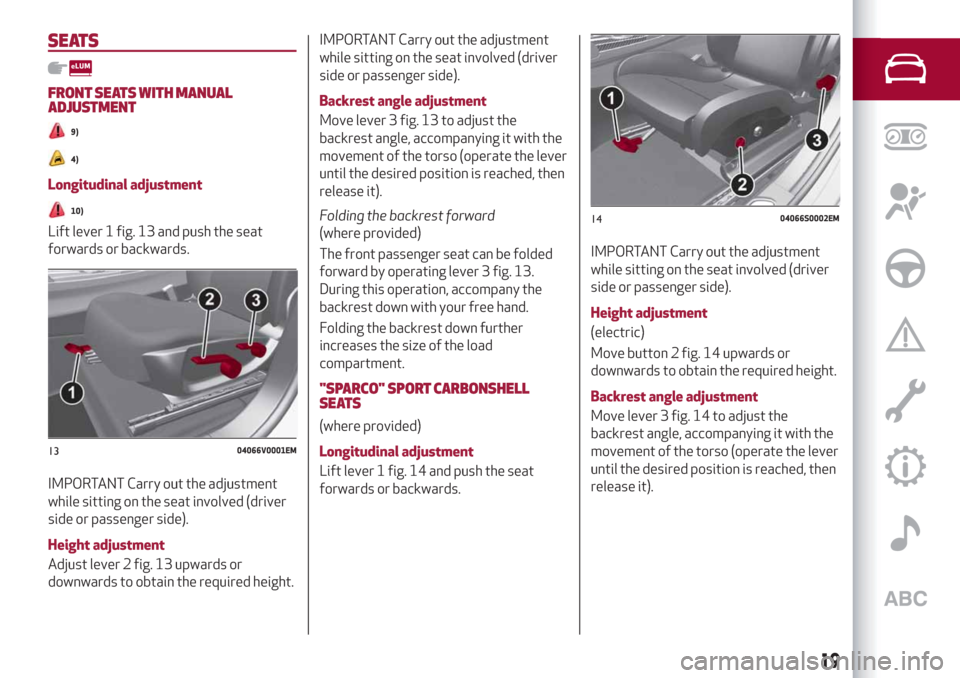
SEATS
FRONT SEATS WITH MANUAL
ADJUSTMENT
9)
4)
Longitudinal adjustment
10)
Lift lever 1 fig. 13 and push the seat
forwards or backwards.
IMPORTANT Carry out the adjustment
while sitting on the seat involved (driver
side or passenger side).
Height adjustment
Adjust lever 2 fig. 13 upwards or
downwards to obtain the required height.
IMPORTANT Carry out the adjustment
while sitting on the seat involved (driver
side or passenger side).
Backrest angle adjustment
Move lever 3 fig. 13 to adjust the
backrest angle, accompanying it with the
movement of the torso (operate the lever
until the desired position is reached, then
release it).
Folding the backrest forward
(where provided)
The front passenger seat can be folded
forward by operating lever 3 fig. 13.
During this operation, accompany the
backrest down with your free hand.
Folding the backrest down further
increases the size of the load
compartment.
"SPARCO" SPORT CARBONSHELL
SEATS
(where provided)
Longitudinal adjustment
Lift lever 1 fig. 14 and push the seat
forwards or backwards.
IMPORTANT Carry out the adjustment
while sitting on the seat involved (driver
side or passenger side).
Height adjustment
(electric)
Move button 2 fig. 14 upwards or
downwards to obtain the required height.
Backrest angle adjustment
Move lever 3 fig. 14 to adjust the
backrest angle, accompanying it with the
movement of the torso (operate the lever
until the desired position is reached, then
release it).
1304066V0001EM
1404066S0002EM
19
Page 22 of 244
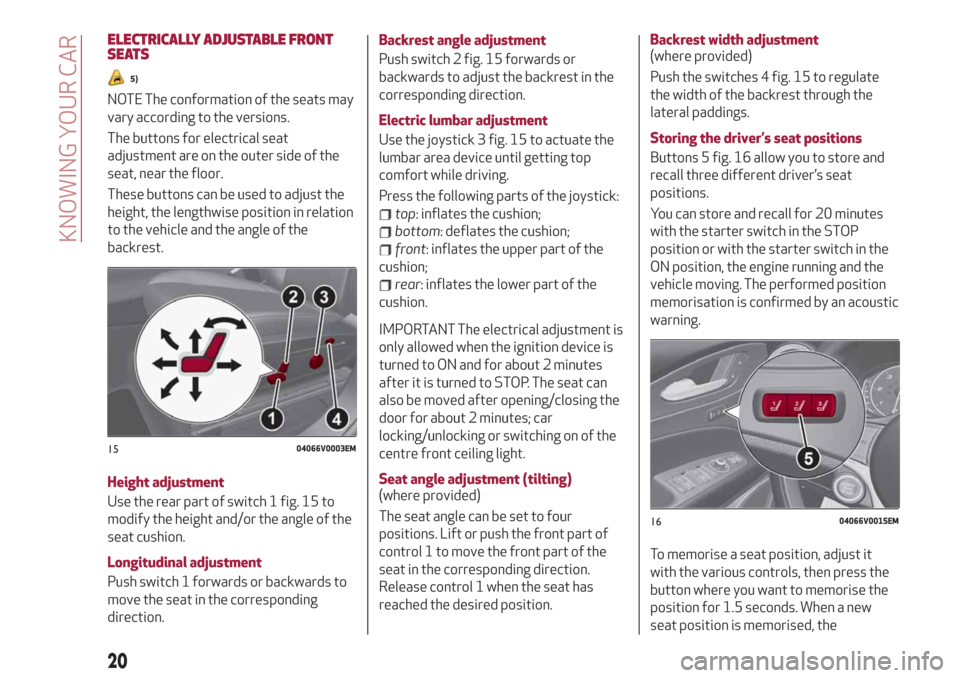
ELECTRICALLY ADJUSTABLE FRONT
SEATS
5)
NOTE The conformation of the seats may
vary according to the versions.
The buttons for electrical seat
adjustment are on the outer side of the
seat, near the floor.
These buttons can be used to adjust the
height, the lengthwise position in relation
to the vehicle and the angle of the
backrest.
Height adjustment
Use the rear part of switch 1 fig. 15 to
modify the height and/or the angle of the
seat cushion.
Longitudinal adjustment
Push switch 1 forwards or backwards to
move the seat in the corresponding
direction.Backrest angle adjustment
Push switch 2 fig. 15 forwards or
backwards to adjust the backrest in the
corresponding direction.
Electric lumbar adjustment
Use the joystick 3 fig. 15 to actuate the
lumbar area device until getting top
comfort while driving.
Press the following parts of the joystick:
top: inflates the cushion;
bottom: deflates the cushion;
front: inflates the upper part of the
cushion;
rear: inflates the lower part of the
cushion.
IMPORTANT The electrical adjustment is
only allowed when the ignition device is
turned to ON and for about 2 minutes
after it is turned to STOP. The seat can
also be moved after opening/closing the
door for about 2 minutes; car
locking/unlocking or switching on of the
centre front ceiling light.
Seat angle adjustment (tilting)
(where provided)
The seat angle can be set to four
positions. Lift or push the front part of
control 1 to move the front part of the
seat in the corresponding direction.
Release control 1 when the seat has
reached the desired position.Backrest width adjustment
(where provided)
Push the switches 4 fig. 15 to regulate
the width of the backrest through the
lateral paddings.
Storing the driver’s seat positions
Buttons 5 fig. 16 allow you to store and
recall three different driver’s seat
positions.
You can store and recall for 20 minutes
with the starter switch in the STOP
position or with the starter switch in the
ON position, the engine running and the
vehicle moving. The performed position
memorisation is confirmed by an acoustic
warning.
To memorise a seat position, adjust it
with the various controls, then press the
button where you want to memorise the
position for 1.5 seconds. When a new
seat position is memorised, the
1504066V0003EM
1604066V0015EM
20
KNOWING YOUR CAR
Page 24 of 244
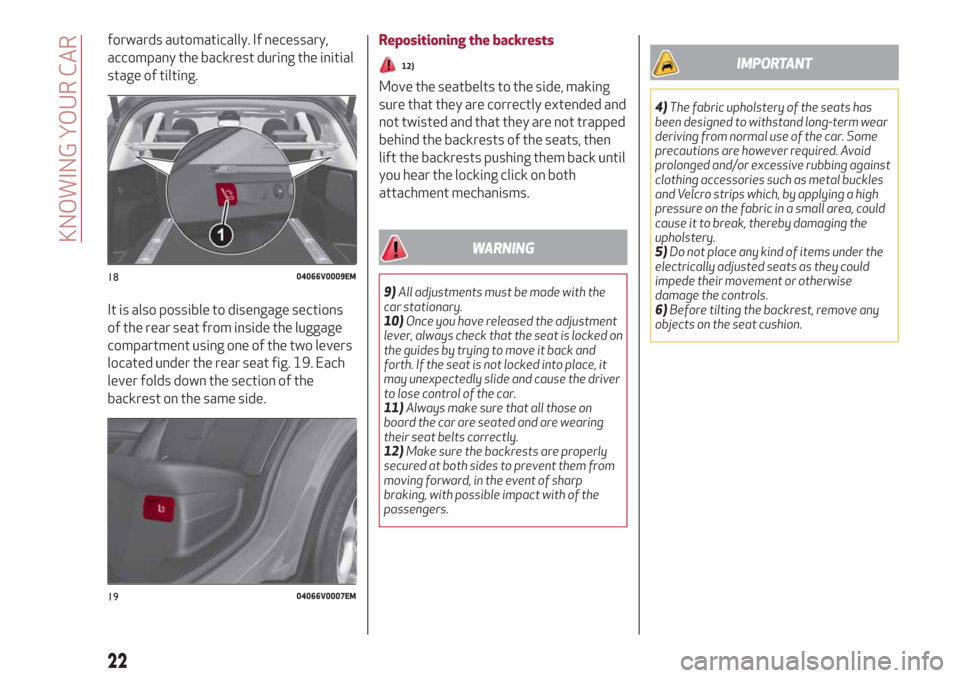
forwards automatically. If necessary,
accompany the backrest during the initial
stage of tilting.
It is also possible to disengage sections
of the rear seat from inside the luggage
compartment using one of the two levers
located under the rear seat fig. 19. Each
lever folds down the section of the
backrest on the same side.Repositioning the backrests
12)
Move the seatbelts to the side, making
sure that they are correctly extended and
not twisted and that they are not trapped
behind the backrests of the seats, then
lift the backrests pushing them back until
you hear the locking click on both
attachment mechanisms.
WARNING
9)All adjustments must be made with the
car stationary.
10)Once you have released the adjustment
lever, always check that the seat is locked on
the guides by trying to move it back and
forth. If the seat is not locked into place, it
may unexpectedly slide and cause the driver
to lose control of the car.
11)Always make sure that all those on
board the car are seated and are wearing
their seat belts correctly.
12)Make sure the backrests are properly
secured at both sides to prevent them from
moving forward, in the event of sharp
braking, with possible impact with of the
passengers.
IMPORTANT
4)The fabric upholstery of the seats has
been designed to withstand long-term wear
deriving from normal use of the car. Some
precautions are however required. Avoid
prolonged and/or excessive rubbing against
clothing accessories such as metal buckles
and Velcro strips which, by applying a high
pressure on the fabric in a small area, could
cause it to break, thereby damaging the
upholstery.
5)Do not place any kind of items under the
electrically adjusted seats as they could
impede their movement or otherwise
damage the controls.
6)Before tilting the backrest, remove any
objects on the seat cushion.
1804066V0009EM
1904066V0007EM
22
KNOWING YOUR CAR
Page 32 of 244
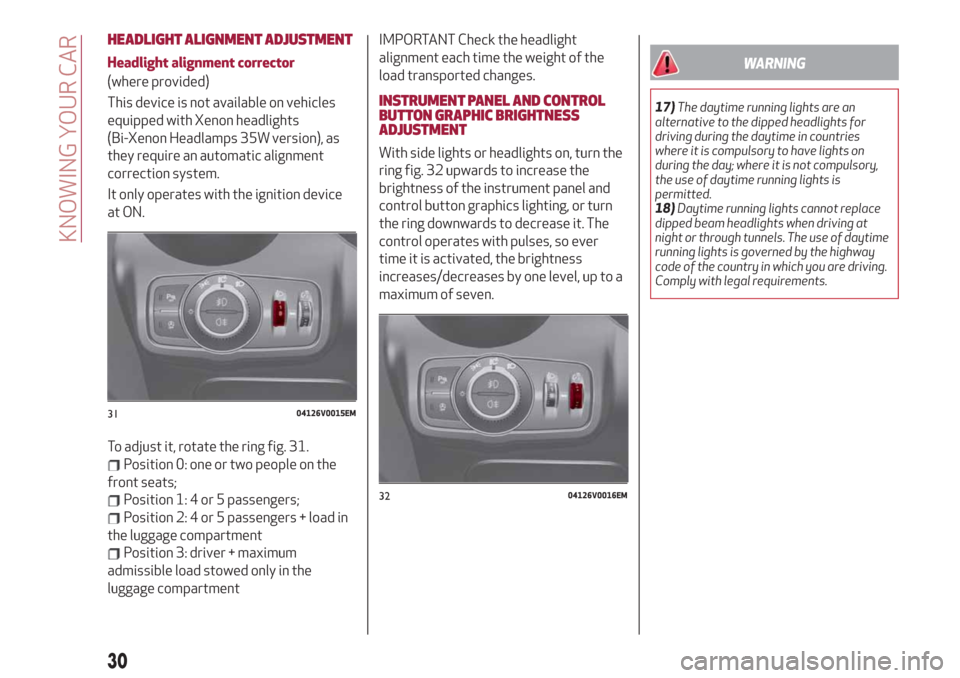
HEADLIGHT ALIGNMENT ADJUSTMENT
Headlight alignment corrector
(where provided)
This device is not available on vehicles
equipped with Xenon headlights
(Bi-Xenon Headlamps 35W version), as
they require an automatic alignment
correction system.
It only operates with the ignition device
at ON.
To adjust it, rotate the ring fig. 31.
Position 0: one or two people on the
front seats;
Position 1: 4 or 5 passengers;
Position 2: 4 or 5 passengers + load in
the luggage compartment
Position 3: driver + maximum
admissible load stowed only in the
luggage compartment
IMPORTANT Check the headlight
alignment each time the weight of the
load transported changes.
INSTRUMENT PANEL AND CONTROL
BUTTON GRAPHIC BRIGHTNESS
ADJUSTMENT
With side lights or headlights on, turn the
ring fig. 32 upwards to increase the
brightness of the instrument panel and
control button graphics lighting, or turn
the ring downwards to decrease it. The
control operates with pulses, so ever
time it is activated, the brightness
increases/decreases by one level, up to a
maximum of seven.
WARNING
17)The daytime running lights are an
alternative to the dipped headlights for
driving during the daytime in countries
where it is compulsory to have lights on
during the day; where it is not compulsory,
the use of daytime running lights is
permitted.
18)Daytime running lights cannot replace
dipped beam headlights when driving at
night or through tunnels. The use of daytime
running lights is governed by the highway
code of the country in which you are driving.
Comply with legal requirements.
3104126V0015EM
3204126V0016EM
30
KNOWING YOUR CAR
Page 35 of 244
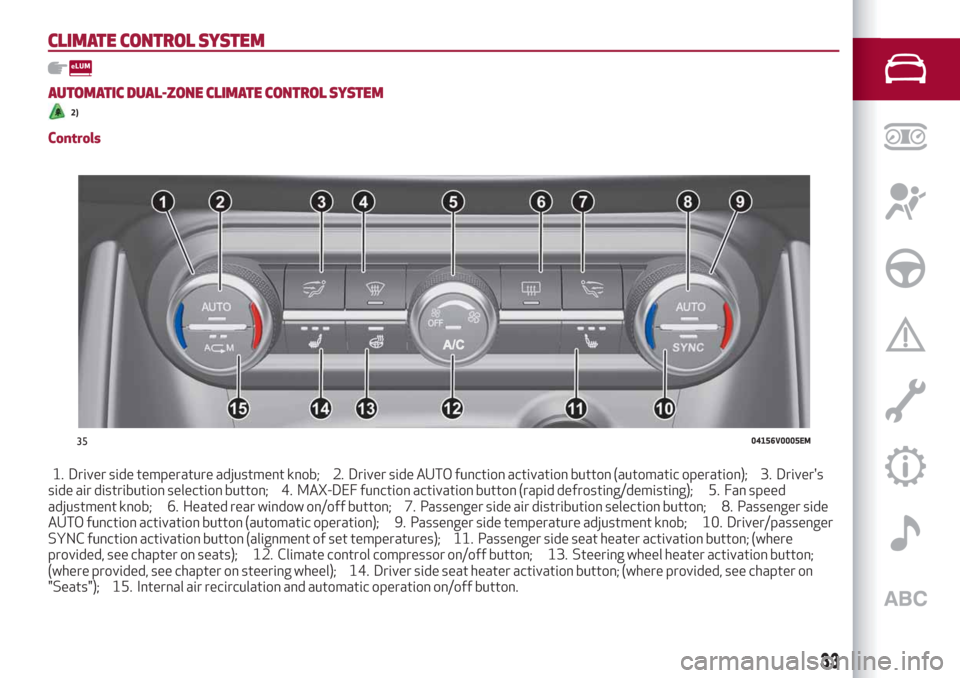
CLIMATE CONTROLSYSTEM
AUTOMATIC DUAL-ZONE CLIMATE CONTROLSYSTEM
2)
Controls
1. Driver side temperature adjustment knob; 2. Driver side AUTO function activation button (automatic operation); 3. Driver's
side air distribution selection button; 4. MAX-DEF function activation button (rapid defrosting/demisting); 5. Fan speed
adjustment knob; 6. Heated rear window on/off button; 7. Passenger side air distribution selection button; 8. Passenger side
AUTO function activation button (automatic operation); 9. Passenger side temperature adjustment knob; 10. Driver/passenger
SYNC function activation button (alignment of set temperatures); 11. Passenger side seat heater activation button; (where
provided, see chapter on seats); 12. Climate control compressor on/off button; 13. Steering wheel heater activation button;
(where provided, see chapter on steering wheel); 14. Driver side seat heater activation button; (where provided, see chapter on
"Seats"); 15. Internal air recirculation and automatic operation on/off button.
3504156V0005EM
33
Page 88 of 244
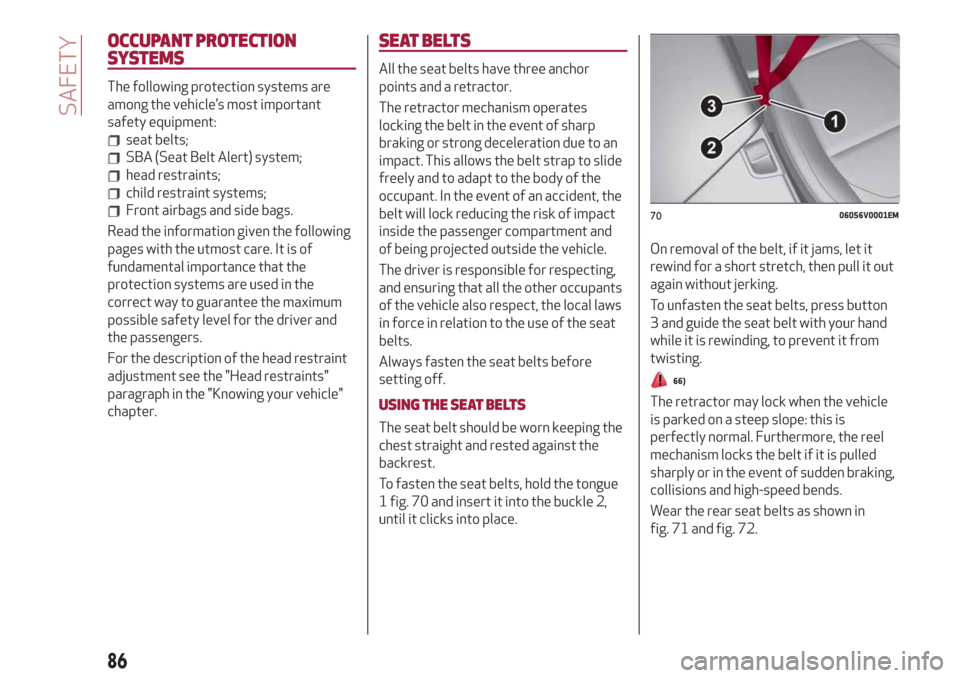
OCCUPANT PROTECTION
SYSTEMS
The following protection systems are
among the vehicle’s most important
safety equipment:
seat belts;
SBA (Seat Belt Alert) system;
head restraints;
child restraint systems;
Front airbags and side bags.
Read the information given the following
pages with the utmost care. It is of
fundamental importance that the
protection systems are used in the
correct way to guarantee the maximum
possible safety level for the driver and
the passengers.
For the description of the head restraint
adjustment see the "Head restraints"
paragraph in the "Knowing your vehicle"
chapter.
SEAT BELTS
All the seat belts have three anchor
points and a retractor.
The retractor mechanism operates
locking the belt in the event of sharp
braking or strong deceleration due to an
impact. This allows the belt strap to slide
freely and to adapt to the body of the
occupant. In the event of an accident, the
belt will lock reducing the risk of impact
inside the passenger compartment and
of being projected outside the vehicle.
The driver is responsible for respecting,
and ensuring that all the other occupants
of the vehicle also respect, the local laws
in force in relation to the use of the seat
belts.
Always fasten the seat belts before
setting off.
USING THE SEAT BELTS
The seat belt should be worn keeping the
chest straight and rested against the
backrest.
To fasten the seat belts, hold the tongue
1 fig. 70 and insert it into the buckle 2,
until it clicks into place.On removal of the belt, if it jams, let it
rewind for a short stretch, then pull it out
again without jerking.
To unfasten the seat belts, press button
3 and guide the seat belt with your hand
while it is rewinding, to prevent it from
twisting.
66)
The retractor may lock when the vehicle
is parked on a steep slope: this is
perfectly normal. Furthermore, the reel
mechanism locks the belt if it is pulled
sharply or in the event of sudden braking,
collisions and high-speed bends.
Wear the rear seat belts as shown in
fig. 71 and fig. 72.
7006056V0001EM
86
SAFETY
Page 227 of 244
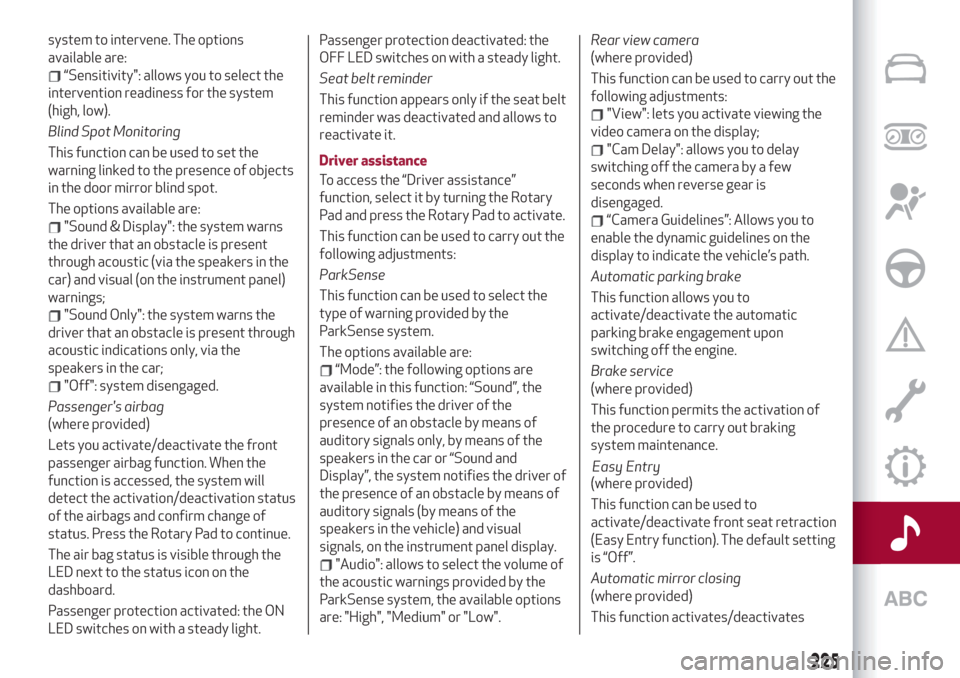
system to intervene. The options
available are:
“Sensitivity": allows you to select the
intervention readiness for the system
(high, low).
Blind Spot Monitoring
This function can be used to set the
warning linked to the presence of objects
in the door mirror blind spot.
The options available are:
"Sound & Display": the system warns
the driver that an obstacle is present
through acoustic (via the speakers in the
car) and visual (on the instrument panel)
warnings;
"Sound Only": the system warns the
driver that an obstacle is present through
acoustic indications only, via the
speakers in the car;
"Off": system disengaged.
Passenger's airbag
(where provided)
Lets you activate/deactivate the front
passenger airbag function. When the
function is accessed, the system will
detect the activation/deactivation status
of the airbags and confirm change of
status. Press the Rotary Pad to continue.
The air bag status is visible through the
LED next to the status icon on the
dashboard.
Passenger protection activated: the ON
LED switches on with a steady light.Passenger protection deactivated: the
OFF LED switches on with a steady light.
Seat belt reminder
This function appears only if the seat belt
reminder was deactivated and allows to
reactivate it.
Driver assistance
To access the “Driver assistance”
function, select it by turning the Rotary
Pad and press the Rotary Pad to activate.
This function can be used to carry out the
following adjustments:
ParkSense
This function can be used to select the
type of warning provided by the
ParkSense system.
The options available are:“Mode”: the following options are
available in this function: “Sound”, the
system notifies the driver of the
presence of an obstacle by means of
auditory signals only, by means of the
speakers in the car or “Sound and
Display”, the system notifies the driver of
the presence of an obstacle by means of
auditory signals (by means of the
speakers in the vehicle) and visual
signals, on the instrument panel display.
"Audio": allows to select the volume of
the acoustic warnings provided by the
ParkSense system, the available options
are: "High", "Medium" or "Low".Rear view camera
(where provided)
This function can be used to carry out the
following adjustments:
"View": lets you activate viewing the
video camera on the display;
"Cam Delay": allows you to delay
switching off the camera by a few
seconds when reverse gear is
disengaged.
“Camera Guidelines”: Allows you to
enable the dynamic guidelines on the
display to indicate the vehicle’s path.
Automatic parking brake
This function allows you to
activate/deactivate the automatic
parking brake engagement upon
switching off the engine.
Brake service
(where provided)
This function permits the activation of
the procedure to carry out braking
system maintenance.
(where provided)
This function can be used to
activate/deactivate front seat retraction
(Easy Entry function). The default setting
is “Off”.
Automatic mirror closing
(where provided)
This function activates/deactivates
225
Easy Entry